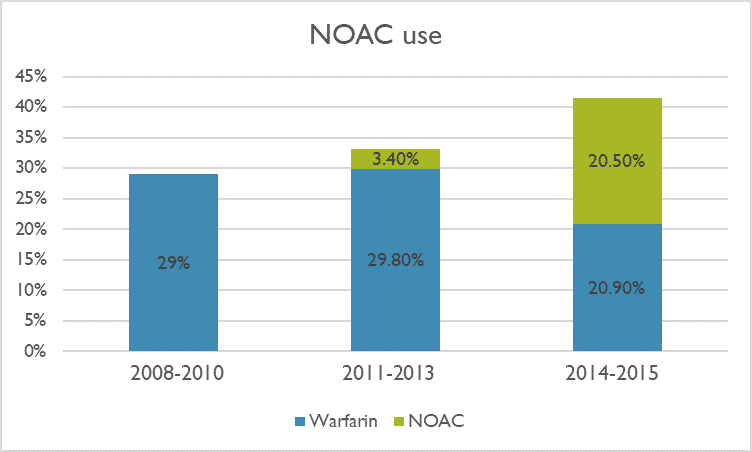
Secular Trends in Warfarin and New Oral Anti-coagulant Therapy in Non-valvular Atrial Fibrillation
2Clalit Research Institute, Clalit Research Institute, Chief Physician's Office, Clalit Health Services
Aims: Oral anticoagulation therapy (OAC) reduces the risk of ischemic stroke and mortality in patients with non-valvular AF while increasing the risk of bleeding, including intracranial hemorrhage. Recently, non-vitamin K antagonist oral anticoagulants (NOACs) have become available and have been associated with lower rates of bleeding. As such, we evaluated the purchasing patterns of OACs across the spectrum of stroke and bleeding risk in order to assess how the introduction of NOACs might have changed OAC treatment paradigm.
Methods and Results: We conducted a prospective, historical cohort study using the Clalit Health Services electronic medical records database. The study population included all Clalit members aged 25 years and older, with a new diagnosis of non-valvular atrial fibrillation (NVAF) between 2008 and 2015. A total of 58,385 cases were identified. The median age was 75 years and 52.3% were women. Most patients (86.4%) had a CHA2DS2-VASc score of 2 or more and 58.9% of patients had a HAS-BLED score ≥3. In 2008-2010, 29% of patients purchased a vitamin K antagonist, the only available OAC at the time. OAC purchasing increased to 41.4% during the period between 2014 and 2015 with half of these being prescribed a NOAC (Figure 1). The preference for NOAC is evident across the whole embolic risk spectrum: NOAC purchasing increased from 1.9% to 15% in those with a CHA2DS2-VASc of 0 and from 4.5% to 29.7% in those with a risk score of 1,while it increased from 10.9% to 51.8% among those at high embolic risk, with CHA2DS2-VASc≥ 2.
Conclusions: In this real world population-based cohort of patients with newly diagnosed NVAF, purchasing of NOAC has risen exponentially in only a few years, accounting for a greater pool of AF patients being prescribed an OAC.


Powered by Eventact EMS